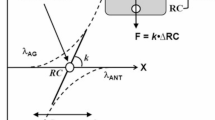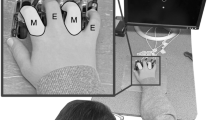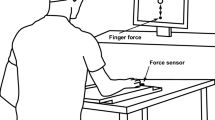Abstract
We explored the phenomena of force drifts and unintentional finger force production (enslaving), and their dependence on visual feedback. Predictions have been drawn based on the theory of control with spatial referent coordinates for condition with feedback on instructed (master) finger force, enslaved finger force, and total force for one-hand and two-hand tasks. Subjects produced force under the different feedback conditions without their knowledge. No feedback condition was also used for the one-hand tasks. Overall, feedback of master finger force led to an increase in the enslaved force, feedback on the slave finger force led to a drop in the master force, feedback on the total force led to balanced drifts in the master force down and enslaved force up, and under the no-feedback condition, master and total force drifted down with large variability in the enslaved force drifts. The patterns were the same in both hands in the two-hand tasks when feedback was provided on the forces of one hand only (without subject’s knowledge). The index of enslaving always drifted toward higher values. We interpret the findings as reflecting three main factors: drifts in the referent coordinates toward actual finger coordinates, spread of cortical excitation over representations of the fingers, and robust sharing of referent coordinates between the two hands in bimanual tasks. The large consistent drifts in enslaving toward higher values have to be considered in studies of multi-finger synergies.









Similar content being viewed by others
Data availability
The original data are available from the corresponding author at a reasonable request.
References
Abolins V, Latash ML (2021) The nature of finger enslaving: new results and their implications. Mot Control 25:680–703
Abolins V, Latash ML (2022) Unintentional force drifts as consequences of indirect force control with spatial referent coordinates. Neuroscience 481:156–165
Abolins V, Stremoukhov A, Walter C, Latash ML (2020) On the origin of finger enslaving: control with referent coordinates and effects of visual feedback. J Neurophysiol 124:1625–1636
Ambike S, Paclet F, Zatsiorsky VM, Latash ML (2014) Factors affecting grip force: anatomy, mechanics, and referent configurations. Exp Brain Res 232:1219–1231
Ambike S, Zatsiorsky VM, Latash ML (2015) Processes underlying unintentional finger force changes in the absence of visual feedback. Exp Brain Res 233:711–721
Ambike S, Mattos D, Zatsiorsky VM, Latash ML (2016) Unsteady steady-states: central causes of unintentional force drift. Exp Brain Res 234:3597–3611
Beck S, Hallett M (2011) Surround inhibition in the motor system. Exp Brain Res 210:165–172
Cuadra C, Corey J, Latash ML (2021) Distortions of the efferent copy during force perception: a study of force drifts and effects of muscle vibration. Neuroscience 457:139–154
Danion F, Schöner G, Latash ML, Li S, Scholz JP, Zatsiorsky VM (2003) A force mode hypothesis for finger interaction during multi-finger force production tasks. Biol Cybern 88:91–98
De Freitas PB, Freitas SMSF, Lewis MM, Huang X, Latash ML (2018) Individual preferences in motor coordination seen across the two hands: relations to movement stability and optimality. Exp Brain Res 237:1–13
De Freitas PB, Freitas SMSF, Reschechtko S, Corson T, Lewis MM, Huang X, Latash ML (2020) Synergic control of action in levodopa-naïve Parkinson’s disease patients: I. Multi-finger interaction and coordination. Exp Brain Res 238:229–245
Diedrichsen J, Shadmehr R, Ivry RB (2010) The coordination of movement: optimal feedback control and beyond. Trends Cogn Sci 14:31–39
Feldman AG (1966) Functional tuning of the nervous system with control of movement or maintenance of a steady posture. II. Controllable parameters of the muscle. Biophysics 11:565–578
Feldman AG (1986) Once more on the equilibrium-point hypothesis (λ-model) for motor control. J Mot Behav 18:17–54
Feldman AG (2009) New insights into action-perception coupling. Exp Brain Res 194(1):39–58 s00221–008-1667-3. https://doi.org/10.1007/s00221-008-1667-3
Feldman AG (2015) Referent control of action and perception: challenging conventional theories in behavioral science. Springer, New York
Feldman AG, Latash ML (1982a) Interaction of afferent and efferent signals underlying joint position sense: empirical and theoretical approaches. J Motor Behav 14:174–193
Feldman AG, Latash ML (1982b) Afferent and efferent components of joint position sense: interpretation of kinaesthetic illusions. Biol Cybern 42:205–214
Feldman AG, Ilmane N, Sangani S, Raptis H (2014) Motor control and position sense: action–perception coupling. Adv Exp Med Biol 826:17–31
Gibson JJ (1979) The ecological approach to visual perception. Houghton Mifflin, Boston
Hirose J, Cuadra C, Walter C, Latash ML (2020) Finger interdependence and unintentional force drifts: lessons from manipulations of visual feedback. Hum Mov Sci 74:102714
Ilmane N, Sangani S, Feldman AG (2013) Corticospinal control strategies underlying voluntary and involuntary wrist movements. Behav Brain Res 236:350–358
Jo HJ, Maenza C, Good DC, Huang X, Park J, Sainburg RL, Latash ML (2016) Effects of unilateral stroke on multi-finger synergies and their feed-forward adjustments. Neuroscience 319:194–205
Kawato M (1999) Internal models for motor control and trajectory planning. Curr Opin Neurobiol 9:718–727
Kilbreath SL, Gorman RB, Raymond J, Gandevia SC (2002) Distribution of the forces produced by motor unit activity in the human flexor digitorum profundus. J Physiol 543:289–296
Koeneke S, Lutz K, Wüstenberg T, Jäncke L (2004) Bimanual versus unimanual coordination: what makes the difference? Neuroimage 22:1336–1350
Latash ML (2019) Physics of biological action and perception. Academic Press, New York
Latash ML (2021a) Laws of nature that define biological action and perception. Phys Life Rev 36:47–67
Latash ML (2021b) Efference copy in kinesthetic perception: a copy of what is it? J Neurophysiol 125:1079–1094
Latash ML (2023) Optimality, stability, and agility of human movement: new optimality criterion and trade-offs. Mot Control 27:123–159
Latash ML, Huang X (2015) Neural control of movement stability: lessons from studies of neurological patients. Neuroscience 301:39–48
Latash ML, Li S, Danion F, Zatsiorsky VM (2002) Central mechanisms of finger interaction during one- and two-hand force production at distal and proximal phalanges. Brain Res 924:198–208
Latash ML (2010) Motor Synergies and the Equilibrium-Point Hypothesis. Motor Control 14(3):294–322. https://doi.org/10.1123/mcj.14.3.294
Leijnse JN, Snijders CJ, Bonte JE, Landsmeer JM, Kalker JJ, Van Der Meulen JC, Sonneveld GJ, Hovius SE (1993) The hand of the musician: the kinematics of the bidigital finger system with anatomical restrictions. J Biomech 10:1169–1179
Li Z-M, Latash ML, Zatsiorsky VM (1998) Force sharing among fingers as a model of the redundancy problem. Exp Brain Res 119:276–286
Li S, Danion F, Latash ML, Li Z-M, Zatsiorsky VM (2000) Characteristics of finger force production during one- and two-hand tasks. Hum Mov Sci 19:897–924
Li S, Danion F, Latash ML, Li Z-M, Zatsiorsky VM (2001) Bilateral deficit and symmetry in finger force production during two-hand multi-finger tasks. Exp Brain Res 141:530–540
Li S, Danion F, Zatsiorsky VM, Latash ML (2002) Coupling phenomena during asynchronous submaximal two-hand, multi-finger force production tasks. Neurosci Lett 331:75–78
Li S, Latash ML, Yue GH, Siemionow V, Sahgal V (2003) The effects of stroke and age on finger interaction in multi-finger force production tasks. Clin Neurophysiol 114:1646–1655
Lund JS, Angelucci A, Bressloff PC (2003) Anatomical substrates for functional columns in macaque monkey primary visual cortex. Cereb Cortex 13:15–24
Park J, Wu Y-H, Lewis MM, Huang X, Latash ML (2012) Changes in multi-finger interaction and coordination in Parkinson’s disease. J Neurophysiol 108:915–924
Pollok B, Butz M, Gross J, Schnitzler A (2007) Intercerebellar coupling contributes to bimanual coordination. J Cogn Neurosci 19:704–719
Poon C, Chin-Cottongim LG, Coombes SA, Corcos DM, Vaillancourt DE (2012) Spatiotemporal dynamics of brain activity during the transition from visually guided to memory-guided force control. J Neurophysiol 108:1335–1348
Ranganathan R, Newell KM (2008a) Online feedback and the regulation of degrees of freedom in motor control. Hum Mov Sci 27:577–589
Ranganathan R, Newell KM (2008b) Motor synergies: feedback and error compensation within and between trials. Exp Brain Res 186:561–570
Raptis H, Burtet L, Forget R, Feldman AG (2010) Control of wrist position and muscle relaxation by shifting spatial frames of reference for motoneuronal recruitment: possible involvement of corticospinal pathways. J Physiol 588:1551–1570
Rasouli O, Solnik S, Furmanek MP, Piscitelli D, Falaki A, Latash ML (2017) Unintentional drifts during quiet stance and voluntary body sway. Exp Brain Res 235:2301–2316
Reas C, Fry B (2007) Processing: a programming handbook for visual designers and artists. MIT Press, Cambridge
Reschechtko S, Latash ML (2017) Stability of hand force production: I. Hand level control variables and multi-finger synergies. J Neurophysiol 118:3152–3164
Sainburg RL (2005) Handedness: differential specializations for control of trajectory and position. Exerc Sport Sci Rev 33:206–213
Schieber MH (1991) Individuated finger movements of rhesus monkeys: a means of quantifying the independence of the digits. J Neurophysiol 65:1381–1391
Schieber MH (2001) Constraints on somatotopic organization in the primary motor cortex. J Neurophysiol 86:2125–2143
Schieber MH, Hibbard LS (1993) How somatotopic is the motor cortex hand area? Science 261:489–492
Schieber MH, Santello M (2004) Hand function: peripheral and central constraints on performance. J Appl Physiol 96:2293–2300
Scholz JP, Schöner G (1999) The uncontrolled manifold concept: identifying control variables for a functional task. Exp Brain Res 126:289–306
Shadmehr R, Wise SP (2004) The computational neurobiology of reaching and pointing: a foundation for motor learning. MIT press
Shinohara M, Li S, Kang N, Zatsiorsky VM, Latash ML (2003) Effects of age and gender on finger coordination in MVC and submaximal force-matching tasks. J Appl Physiol 94:259–270
Slifkin AB, Vaillancourt DE, Newell KM (2000) Intermittency in the control of continuous force production. J Neurophysiol 84:1708–2171
Slobounov S, Chiang H, Johnston J, Ray W (2002) Modulated cortical control of individual fingers in experienced musicians: an EEG study. Clin Neurophysiol 113:2013–2024
Turvey MT (1990) Coordination. American psychologist 45(8):938
Vaillancourt DE, Russell DM (2002) Temporal capacity of short-term visuomotor memory in continuous force production. Exp Brain Res 145:275–285
Vaillancourt DE, Slifkin AB, Newell KM (2001) Visual control of isometric force in Parkinson’s disease. Neurophysiologia 39:1410–1418
Vaillancourt DE, Thulborn KR, Corcos DM (2003) Neural basis for the processes that underlie visually guided and internally guided force control in humans. J Neurophysiol 90:3330–3340
van Duinen H, Gandevia SC (2011) Constraints for control of the human hand. J Physiol 589:5583–5593
von Schroeder HP, Botte MJ, Gellman H (1990) Anatomy of the juncturae tendinum of the hand. J Hand Surg 15:595–602
Wolpert DM, Miall RC, Kawato M (1998) Internal models in the cerebellum. Trends Cogn Sci 2:338–347
Zatsiorsky VM, Li ZM, Latash ML (2000) Enslaving effects in multi-finger force production. Exp Brain Res 131:187–195
Zhou T, Zhang L, Latash ML (2015) Intentional and unintentional multi-joint movements: their nature and structure of variance. Neuroscience 289:181–193
Funding
This study received no external funding support.
Author information
Authors and Affiliations
Corresponding authors
Ethics declarations
Conflict of interest
No conflict of interest is claimed by any of the authors.
Additional information
Communicated by Bill J. Yates.
Publisher's Note
Springer Nature remains neutral with regard to jurisdictional claims in published maps and institutional affiliations.
Rights and permissions
Springer Nature or its licensor (e.g. a society or other partner) holds exclusive rights to this article under a publishing agreement with the author(s) or other rightsholder(s); author self-archiving of the accepted manuscript version of this article is solely governed by the terms of such publishing agreement and applicable law.
About this article
Cite this article
Abolins, V., Ormanis, J. & Latash, M.L. Unintentional drifts in performance during one-hand and two-hand finger force production. Exp Brain Res 241, 699–712 (2023). https://doi.org/10.1007/s00221-023-06559-z
Received:
Accepted:
Published:
Issue Date:
DOI: https://doi.org/10.1007/s00221-023-06559-z




